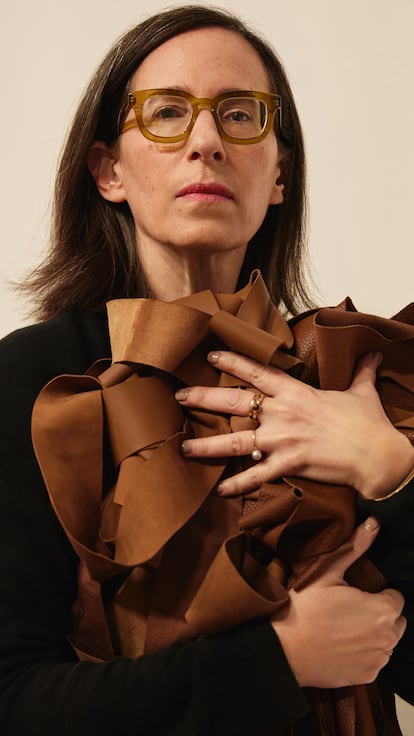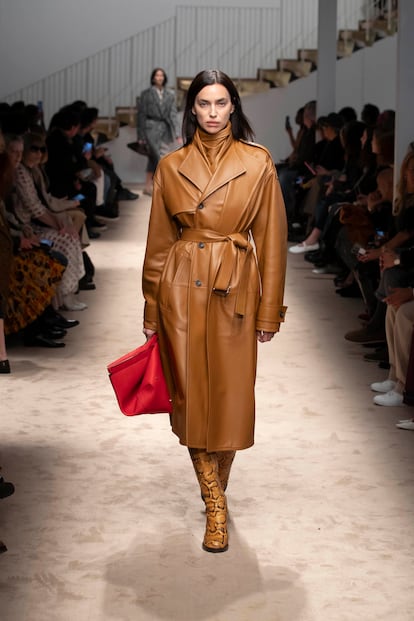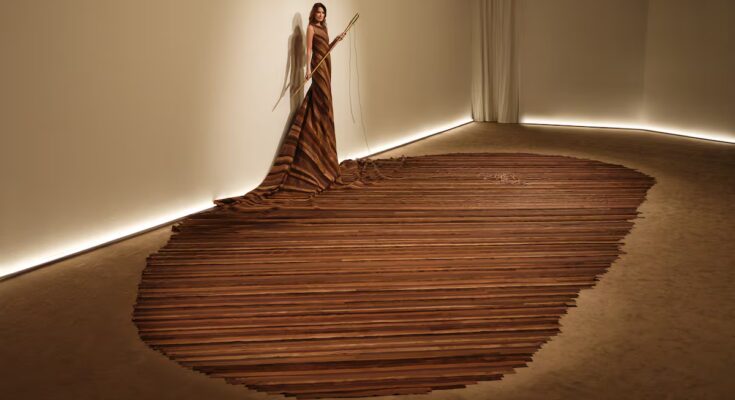The first thing Matteo Tamburini does when faced with a collection is not to draw or sculpt on a mannequin, but to touch different materials until he finds inspiration. “I like working with tactile contrasts (nappa, suede, jacquard…) and reinterpreting them with new treatments and unexpected combinations,” he explains. Since 2023 he has been working in the ideal place to touch and model: Tod’s, the historic Italian brand based in the Marche, a region in central Italy famous for its tanneries and leather workshops.
Tamburini arrived two years ago in this brand that focuses entirely on classicism, craftsmanship and various timeless products (such as the Gommino moccasins or the D Bag bag), but in reality it was as if he had always been there. He grew up in Pesaro, in the region itself, surrounded by leather workshops and in a family that worked making and renting theatrical costumes. He went through several brands (including Marco Zanini’s Schiaparelli, a brand also owned by Tod’s owner Diego Della Valle) and ended up designing Bottega Veneta accessories, meaning some leather bags and shoes are his.
The first Tamburini parade in front of Tod’s took place in the tram depots of Milan. The setting was a statement of intent: good design should not be at odds with the daily hustle and bustle. “For me innovation doesn’t have to scream,” he says, “sometimes it’s in the proportions or a specially placed seam, or the way a bag is folded. Design advances in the details.” Two years have passed since then and Tamburini has become, in record time, one of the most popular designers in the fashion world. The recipe for its success is based on having added the right doses of design to a brand focused on classicism. He downplays it: “Tod’s has had a strong identity for decades. This is a gift for a designer, but also a responsibility,” he says. “I set myself the challenge of not altering that identity, but making it resonate in another time,” he says. His vision adds wrinkles, new textures, small asymmetries and sometimes designs that transcend gender to the brand. He defines it as “designing a brand that is more human, more open, more alive and even more porous,” he says.

In May 2024 Tod’s managed to withdraw from the Milan Stock Exchange, where it had been listed for almost two decades, and to become a private company, one-third owned by L Catterton, the investment fund of the LVMH group. «By becoming a private company, Tod’s can plan investments, launches and strategies with longer deadlines», explains its owner, Diego Della Valle. Not having to account to shareholders also translates into a readjustment of expectations. In times of recession in the luxury market, Tod’s focuses on creativity, even if in a limited way. In this sense, Tamburini believes that “the luxury customer today seeks meaning, not just status or novelty”.

Now that all the reports in the sector speak of a renewed appreciation for craftsmanship and quality materials, Tod’s, which last year had a turnover of 122 million euros, is halfway there, but something more is needed: “There is quality and craftsmanship, but also a necessary emotional part”, says the designer, who does not want to fall into the trite category of ‘silent luxury’. “I understand why people use this term, but I don’t completely identify with it. I don’t want to be quiet or strident, I want to be honest and be authentic,” he says. Its authenticity is based on letting the materials speak, letting touch give rise to shape and shape to colour. “There’s a sense of sensuality, something earthly that always has to do with the material and the way the things you wear age,” she explains. Faced with continuous novelty, Tamburini is interested in the passage of time. In fact, the design thinks about how the textures and colors will vary in the future. “I work with a wardrobe in mind, not a show,” he says, “I try to use natural pale tones. As if the skin were a canvas.” Therefore, among his immediate references are names such as Carla Accardi, Alberto Burri or Lucio Fontana, plastic artists who understood beauty as something that is built on matter itself.

Tamburini believes that the famous made in Italy, rather than a seal of quality, is an attitude: “I see it as a sort of ideal. A contained, but not anonymous elegance”, he says, “a wardrobe of elevated but true garments”. In an environment of collections presented as a spectacle, of dizzying trends and viral battles, the designer claims slow time: “Listen first to the environment and then to my team. Only then will I be able to do things with meaning.”
Tod’s is not looking for double-digit growth by saturating the market with products. Nor does it become one of those passing successes. He never wanted it. His commitment to Tamburini is the greatest proof of this: far from the noise, he has decided to trust in the solidity of the craft and in an idea of luxury that claims origin, craftsmanship and practicality. It’s not the path many would like to take right now, but perhaps it’s the best path, because you enjoy the journey, not just the goal.





